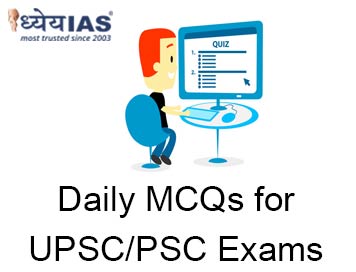Home > Daily-mcqs
Daily-mcqs 23 Aug 2025

Q1:
Consider the following statements regarding Fortified Rice: 1. Fortified rice is regular rice infused with micronutrients like iron, folic acid, and vitamin B12. 2. Fortified rice is distributed only through the Mid-Day Meal Scheme. 3. The Universal Fortified Rice Scheme was initially launched in 2019 for up to 2024. 4. It is now extended till the year 2030. How many statements given above is/are correct?
A: Only 1
B: Only 2
C: Only 3
D: All of the above
Answer: B
Explanation:
Q2:
1. The Transplantation of Human Organs Act, 1994 allows both live and brain-stem dead organ donations. 2. The Act permits commercial organ donation with regulatory approval. 3. The Act was amended in 2011 to include tissue donation. Which of the statements is/are correct?
With reference to the legal framework for organ donation in India, consider the following statements:
A: 1 and 2 only
B: 1 and 3 only
C: 2 and 3 only
D: All of the above
Answer: B
Explanation:
· Statement 1 is correct: The Act recognizes live and brain-stem dead donors.
· Statement 2 is incorrect: Commercial organ transactions are prohibited.
· Statement 3 is correct: The 2011 amendment included provisions for tissue donation.
Q3:
Section 12(1)(c) of the Right to Education Act, 2009, mandates for private unaided schools to:
A: Reserve 10% of seats for SC/ST students.
B: Provide 25% reservation for EWS and disadvantaged children.
C: Offer free education only to girls from rural areas.
D: Reserve 33% seats for OBC students.
Answer: B
Explanation:
· Section 12(1)(c) mandates 25% reservation in private unaided schools for Economically Weaker Sections (EWS) and disadvantaged groups. Recently, Parliamentary panel recommended a similar model for private higher education.
Q4:
Assertion (A): India opposes the China-Pakistan Economic Corridor (CPEC) 2.0.
Reason (R): CPEC 2.0 includes infrastructure development in Pakistan-occupied Jammu & Kashmir, which India claims as its sovereign territory.
A: Both A and R are true, and R is the correct explanation of A.
B: Both A and R are true, but R is not the correct explanation of A.
C: A is true, but R is false.
D: A is false, but R is true.
Answer: A
Explanation:
Q5:
The National Council on India’s Nutrition Challenges, which reviews nutrition-related convergence, is chaired by:
A: Prime Minister of India
B: Minister of Women and Child Development
C: Vice-Chairman of NITI Aayog
D: Cabinet Secretary
Answer: C
Explanation:
The National Council provides policy direction for multi-sectoral coordination and is chaired by the Vice-Chairman of NITI Aayog.